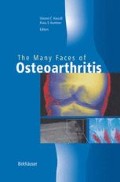Abstract
It is well known that osteoarthritis (OA) is associated with advancing age. However, a large number of elderly people do not develop OA and a survey of aged cartilage, in the absence of degeneration, reveals unchanged physico-chemical characteristics. The object of this article is to describe some of the physical properties of femoral head and femoral condyle cartilage as a function of age and in OA. The properties with which we shall deal are the osmotic pressure of proteoglycan (PG) extracted from cartilage and the stiffness of the collagen network.
Access this chapter
Tax calculation will be finalised at checkout
Purchases are for personal use only
Preview
Unable to display preview. Download preview PDF.
References
Stockwell RA (1970) Changes in the acid glycosaminoglycan content of the matrix of human cartilage. Ann Rheum Dis 29: 509–515
Hjertquist SO, Lemperg RC (1967) Identification and concentration of the glycosamino-glycans of human articular cartilage in relation to age and osteoarthritis. Calcified Tissue Research 10: 223–227
Venn MF (1978) Variation of chemical composition with age in human femoral head cartilage. Ann Rheum Dis 37: 168–174
Bayliss MT (1986) Proteoglycan structure in normal and osteoarthrotic human cartilage . In: K Kuettner et al (eds): Articular cartilage biochemistry. Raven Press, New York, 295–310
Bayliss MT (1990) Extraction and purification of proteoglycan and hyaluronan from human articular cartilage. In: A Maroudas, K Kuettner (eds): Methods in cartilage research. Academic Press, London, 220–222
Maroudas A, Bayliss MT, Uchitel-Kaushansky N, Schneiderman R, Gilav E (1998) Aggrecan turnover in human articular cartilage: Use of aspartic acid racemization as a marker of molecular age. Arch Biochem Biophys 350(1): 61–71
Urban JPG, Maroudas A, Bayliss MT, Dillon J (1979) Swelling pressures of proteoglycans at the concentrations found in cartilaginous tissues. Biorheology 16: 447–464
Maroudas A, Bayliss MT, Venn MF (1980) Further studies on the composition of human femoral head cartilage. Ann Rheum Dis 39: 514–523
Grushko G, Schneiderman R, Maroudas A (1989) Some biochemical and biophysical parameters for the study of the pathogenesis of osteoarthritis: A comparison between the processes of ageing and degeneration in human hip cartilage. Conn Tiss Res 19: 149–176
Basser PJ, Schneiderman R, Bank RA, Wachtel E, Maroudas A (1998) Mechanical properties of the collagen network in human articular cartilage as measured by osmotic stress technique. Arch Biochem Biophys 351(2): 207–219
Bank RA, Bayliss MT, Lafeber FPJG, Maroudas A, Tekoppele JM (1998) Ageing and zonal variation in posttranslational modification of collagen in normal human articular cartilage. Biochem J 330: 345–351
Mizrahi J, Maroudas A, Lanir Y, Ziv I, Weber TJ (1986) The (instantaneous) deformation of cartilage: Effects of collagen fiber orientation and osmotic stress. Biorheology 23: 311–330
Bank RA, Soudry M, Maroudas A, Mizrahi J, TeKoppele JM (2000) The increased swelling and instantaneous deformation of osteoarthritic cartilage is highly correlated with collagen degradation Arthritis Rheum 43(10): 2202–2210
Hollander AP, Pidoux I, Reiner A, Rorabeck C, Bourne R, Poole AR (1995) damage to type II collagen in ageing and osteoarthritis: starts at the articular surface, originates around chondrocytes, and extends into the cartilage with progressive degeneration. J Clin Invest 96: 2859–2869
Author information
Authors and Affiliations
Editor information
Editors and Affiliations
Rights and permissions
Copyright information
© 2002 Springer Basel AG
About this paper
Cite this paper
Ben-Zaken, H., Schneiderman, R., Kaufmann, H., Maroudas, A. (2002). Age-dependent changes in some physico-chemical properties of human articular cartilage. In: Hascall, V.C., Kuettner, K.E. (eds) The Many Faces of Osteoarthritis. Birkhäuser, Basel. https://doi.org/10.1007/978-3-0348-8133-3_24
Download citation
DOI: https://doi.org/10.1007/978-3-0348-8133-3_24
Publisher Name: Birkhäuser, Basel
Print ISBN: 978-3-0348-9450-0
Online ISBN: 978-3-0348-8133-3
eBook Packages: Springer Book Archive

